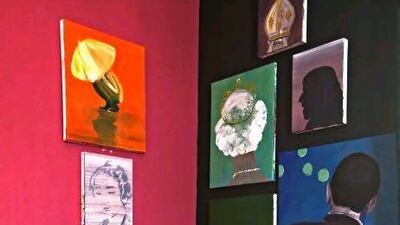We drop by the home studio of the Iranian artist Hesam Rahmanian to discuss the benefits, challenges and complexities of living in close quarters with his artwork, as well as two rather prominent housemates.
Living and working alongside two major artists while attempting to carve out a career of your own can be a tough tightrope to tread for an emerging painter.
Hesam Rahmanian left Iran a decade ago to pursue a postgraduate degree in fine art, but found that making ends meet in San Francisco was putting his painting on the back burner and pushing him further into freelance design.
He moved to Dubai three years ago, swapped design for the full-time life of an artist and now shares a house in Al Barsha with Rokni and Ramin Haerizadeh, two of Iran's most eminent contemporary artists.
"I was surrounded by their works," says Rahmanian. "When I finished a painting, I would notice features about it that reminded me of Rokni's painting."
Indeed, the influence of Rokni - known primarily as a painter of scenes layered with multiple narratives and wrought by a visceral hand - is clear in Rahmanian's early works when he was beginning his search for a painterly voice. "It was natural, and I never denied it. But the technique that I'm now using follows from my mood. It gradually changed after we stopped working in our studio in Al Quoz and moved into this house in Barsha. Now I sleep with the works, I wake up to them. I think that has been very important."
The process
Sloughing off a design way of thinking has been Rahmanian's journey over the past three years. "You have a mindset about designing for a concept. That meant that, at the start, I was painting for a concept, too.
"When I arrived in Dubai in 2009, the uprisings in Iran over the election results - the Green Revolution - were just taking place. I found that I was painting political things; painting for a particular audience. I used to think: 'I feel very calm today, but to complete this work I have to try to paint a tank or something destructive.' Now I'm trying to follow through my mood instead."
The process of painting, Rahmanian explains, has overtaken the illustrative dimension seen in his early work. "Painting is about painting over and over until you're happy and the time that you spend doing that is joyful. I have done conceptual work since moving here as well, but I find that to be more laborious; you have a concept and you execute it. But with painting, even if I'm working from a photograph, I really don't know how it's going to come out and that's the joy in it."
The working week
Canvases in various states of completion are stacked at the end of the artist's bed, the floor is papered for stray drips of paint and his bedroom-cum-studio is bare beyond the tools of sleeping and daubing. Rahmanian says that living with his art has forged a seven-days-a-week rhythm - he tends to roll up his sleeves by 8am. "I had a couple of shows when I was in the US but I never had enough room to work and my room was designed for graphic design jobs." Noticeably, there's no towering Mac in his industrious new abode.
The inspiration
A swan struggling in the grip of a butcher and depictions of the grisly pomp of a matador finishing off a bull all point to Rahmanian's use of cruelty to frame a fundamental tension in each of his paintings. "There's always a winner and a loser in my works," he says, and explains that even though animals bear the brunt of this cruelty in his scenes, there are also echoes of uncomfortably familiar human atrocity.
The continuing search for his own painterly voice is clear in a number of images on the walls of the studio. Many of the stronger works have a canvas engorged with layers of paint as a background. "The works go through a journey themselves," he says, pointing to an image of a horse hoisted on a meat hook with its legs being pulled by a spindly onlooker against a heavy brown background. "Maybe underneath this image was once an image of a car crashing, or a rooster. As the work changes and new layers are added, I think that journey is vital to the final scene."
Getting seen
In April last year, Rahmanian exhibited at Paradise Row in London. "I had about three months to get the show together and in the end produced 22 pieces. I was painting until the early hours of the morning every day.
"But I enjoyed it simply because I was working: being invited to show there gave me a lot of energy and this came into the works. Although I will say, I felt the works became more mature and cohesive in terms of technique and concept as it got closer to the time of the show."
Rahmanian had exhibited with Traffic before the Dubai gallery ceased representing artists earlier this year and was a finalist for the Magic of Persia art prize in 2011. Now he's steadily preparing for a show at Gallery Isabelle van den Eynde, in Al Quoz, to be held next year and is playing with works that have bars of neon lights screwed into the surface of the canvas. "I like the sense of depth it creates," he says, "and this strange illusion between the background and foreground."
More of Hesam Rahmanian's work can be seen at www.ivde.net.
Follow
Arts & Life on Twitter
to keep up with all the latest news and events

